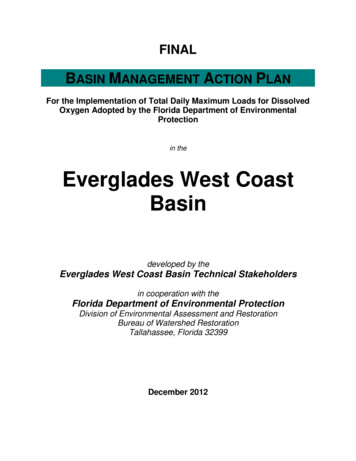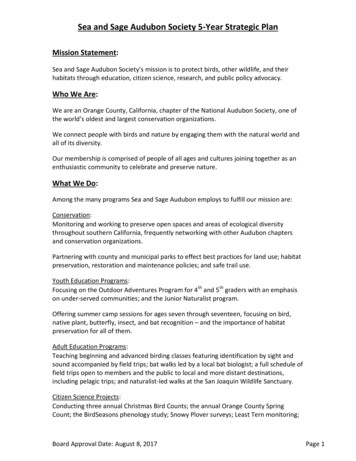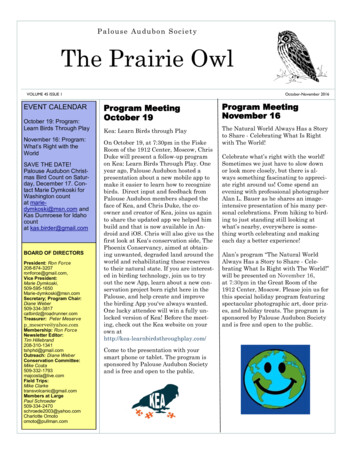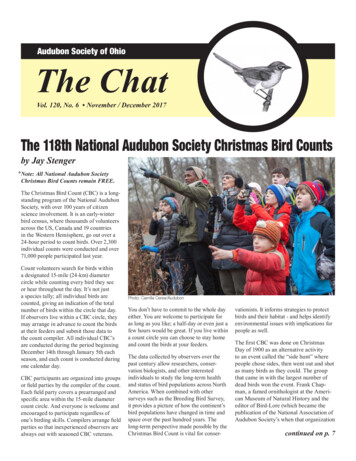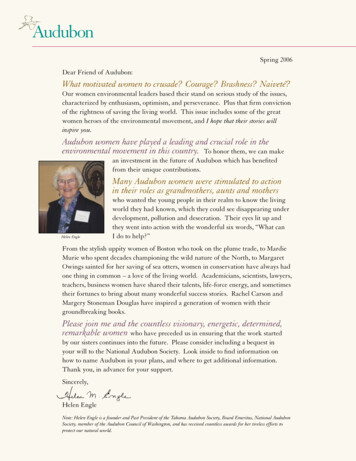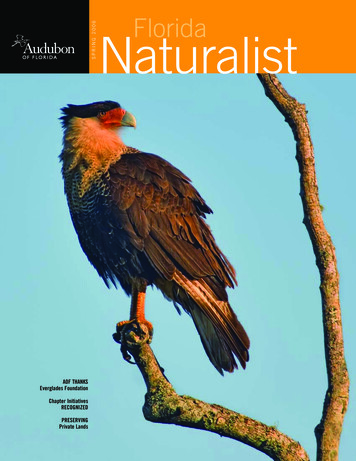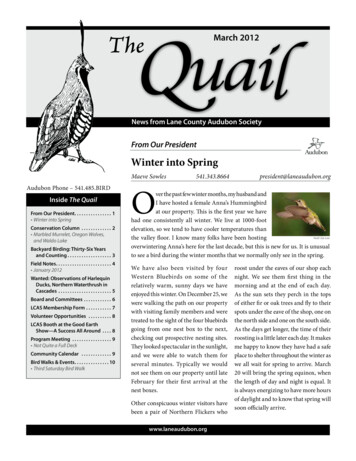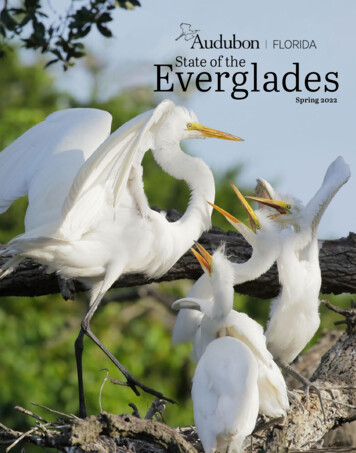
Transcription
EvergladesState of theSpring 2022
Common Gallinule. Photo: David KorteMomentum is finally flowing into the River ofGrass. The federal government has dedicatedmore than one billion dollars to Evergladesrestoration, a historic level. Major projectshave been completed or broken ground (pg8), the last piece of the Cape Sable restorationpuzzle has finally been funded (pg 3), andnew federal legislation could continue theresearch and monitoring South Floridadesperately needs (pg 2). And yet we mustremain vigilant. During the 2022 legislativesession, a bill was rushed through the processthat would have had devastating impactsnot only on Everglades water projects, butland conservation in Florida as a whole.You made your voice heard, writing to yourelected officials as SB 2508 moved throughthe legislature. As a result, its most harmfulprovisions were improved, though notcompletely fixed. Thank you for supportingour work and defending the Everglades.Sincerely,Kelly Cox, Director of Everglades Policykelly.cox@audubon.orgGreat Egret sporting its breeding plumage. Photo:Frances Gaines/Audubon Photography AwardsNew Federal Bill Would ReauthorizeResearch and Monitoring Program forSouth FloridaIn March, Senator Marco Rubio and Representative CarlosGimenez introduced the South Florida Ecosystem EnhancementAct to reauthorize the South Florida Geographic Program(SFGP), an EPA-run program advancing ecological research,monitoring, and education throughout South Florida.This legislation would benefit South Florida’s beaches, coralreefs, bays, and estuaries with an expanded scope to include theIndian River Lagoon National Estuary Program and the Coastaland Heartland National Estuary Partnership. Over the next fiveyears, the bill calls for providing 50 million annually to theSFGP, which has historically received 3 to 10 million per year.Cover: Great Egret fledglings clamor for foodfrom their parent. Photo: Charlie Causey2 Audubon Florida“This is a historic investment in the South Florida GeographicProgram,” said Audubon Florida’s Executive Director JulieWraithmell. “We applaud Senator Rubio and RepresentativeGimenez for their commitment to reauthorizing this importantconservation investment across the South Florida footprint.”
Cape Sable’s canals have driven harmfulerosion of interior marshes and sedimentationof Florida Bay. Finally, Audubon’s plan forrestoration is coming to fruition.Photo: Alex Blochel/Audubon FloridaCape Sable Canal Dam Restoration Finally FundedAfter decades of overdrainage, or shunting water tothe coast instead of letting it flow naturally through theEverglades, the final piece of the Cape Sable restorationpuzzle has been funded by the National Coastal WetlandConservation Grant Program under the U.S. Fish andWildlife Service. Audubon’s long history of research onFlorida Bay and Cape Sable first called attention to theseaccelerating problems and has been steadily prescribingrestoration and enlisting support for it — with steadyprogress — for more than a decade.Located at the southwestern tip of the Florida peninsulaand within Everglades National Park, Cape Sable hasbeen drained by canals since the 1930s. The 15-footwide canals were dug through wetlands to make way foragricultural land and development, but later abandoned.After Cape Sable became part of Everglades NationalPark in 1947, staff plugged the canals with earthendams in an effort to keep more freshwater on the land.Unfortunately, over the next several decades persistentanglers illegally digging through the dams as well ashurricane overwash repeatedly breached the plugs.Without the dams firmly in place, the canals grew insize with each tidal cycle. They expanded up to fivetimes their original width and deepened as more waterrushed through — from a mere one to two feet to 11 or12 feet. This enabled salt water to penetrate freshwatermarshes, converting wetlands to open marshes, erodingthe peat soil, and allowing mud flats to now partially fillthe largest lake in the area, Lake Ingraham. The resultingfragile ecosystem thus became particularly vulnerable toclimate change and rising seas. In fact, sea levels in thearea have increased an alarming five inches since 2000alone, harming the coasts and freshwater wetlands.In 2012, the National Park Service installed dams madeof metal, concrete, stone, and earth on the two largestcanals. Five years later, when Hurricane Irma hit thepeninsula, scientists at Audubon’s Everglades ScienceCenter assessed the impact that the storm had onrestored wetlands and compared with other areasstill unrestored. Their observations revealed a markeddifference, with restored wetlands exhibiting enhancedresilience and less damage. The resulting evidenceconfirms that these restoration efforts not only restorewildlife habitat, but also offer protection against coastalstorm damage.Another canal, named for the Raulerson Brothers whoonce attempted to farm there, also breached. Thoughtemporarily plugged with sandbags on numerousoccasions, these efforts ultimately failed and severeerosion continued. Measurements in December 2021showed that the canal increased to more than 70 feetwide and 11 feet deep. Now, a collaborative effort led byAudubon Florida’s Everglades Science Center, NationalAudubon Society, the National Park Service, andDucks Unlimited, with the involvement of federal andstate wildlife agencies and past involvement from theEverglades Foundation, will finally plug the RaulersonBrothers canal.Achieving this milestone will protect against hurricanesby restoring critical marshes and the natural flow ofwater in the area. Without the completion of remainingrestoration efforts like this one, unrestrained tidalexchange will continue to cause erosion and salinizationof freshwater wetlands, adversely impacting wildlife andsubmerged aquatic vegetation in many ways.Audubon Florida has provided scientific data andmonitoring to support this project, while DucksUnlimited is managing the project construction. Theproject is estimated to cost between 5 and 7 millionand is scheduled to begin in the winter of 2022. After adecade of Audubon science and advocacy on this issue,we look forward to finally celebrating the benefits tohabitat and wildlife that will result from its completion.Audubon Florida 3
An aerial view from May 2021shows mulching in progress(brown completed, green tobe done) in the North Marsh atCorkscrew Swamp Sanctuary.The same area as the previousphoto in September 2021, aftercompletion of mulching andrehydration by the summer rains.Restoration Progress at Corkscrew SwampSanctuary Ebbs and Flows with Water LevelsAudubon has an ambitious goal to restore 1,000 acres of marsh andwet prairie habitat at Corkscrew Swamp Sanctuary by 2023, and we’realready seeing extraordinary results from our efforts.The mosaic of upland and wetlands habitats found in the Sanctuarywas once common throughout Southwest Florida, but has been lost todevelopment in many places since the 1950s. What remains, in placeslike Corkscrew Swamp Sanctuary, is further threatened by degradation,resulting from ditching and draining of the larger watershed.One mechanism of wetland decline at Corkscrew Swamp Sanctuaryhas been the invasion of opportunistic native woody shrubs and treeslike Carolina willow that have taken advantage of drier conditions.In turn, these willow thickets are resistant to prescribed fire, whichcan accelerate conversion of the marsh. The resulting habitat loss isharmful to everything from plant diversity to foraging Wood Storks.Sanctuary staff are hard at work transforming these shrub-dominatedlandscapes back into highly productive and biologically diversewetlands. The three-step restoration process includes mechanicalshredding of woody shrubs and trees; follow-up treatments withherbicide to encourage the reestablishment of desirable species; andfinally, prescribed fire. Drone imagery is improving accuracy as wemeasure the project’s progress and provides a more comprehensiveview of the results. We anticipate that this initiative will serve as amodel for other land management programs across Florida, includingareas with similar infestations in the Corkscrew Regional EcosystemWatershed (CREW).4 Audubon FloridaThe return of species like WoodStorks to this habitat soon afterrestoration are a measure of itssuccess. Photo: Jacob Zetzer/Audubon FloridaTo date, the team has completed Phase 1mulching, and Phase 2 spot treatment isunderway on more than 850 acres, whichincludes 70 acres that are now underprescribed fire management (Phase 3). InMarch, Sanctuary staff began preparingfor mulching 200 acres this season.In addition to improving wildlifehabitat, restoring these wetlands willreduce wetland water loss and therisk of catastrophic wildfire, providingtremendous benefit to local communities.Because wetlands sequester nutrientsthat can degrade water quality andprovide natural water storage to reduceflooding, the project is a real step torecharge the natural systems fundamentalto water quality in Southwest Florida.We look forward to managing CorkscrewSwamp Sanctuary so that our wetlandscontinue to meet the needs of wildlife andresidents, while providing a recreationaland spirit-nurturing resource for our100,000 visitors each year.
Infrastructure Investmentand Jobs Act of 2021 andthe EAA ReservoirIn November 2021, President Biden signedthe bipartisan, 1.2 trillion InfrastructureInvestment and Jobs Act (IIJA) into law.The IIJA includes funding for transportation,environmental infrastructure, disasterresponse, and more. In January of this year,the White House announced that 1.1 billionof these funds would go to the Army Corps ofEngineers (Corps) in Jacksonville to supporttheir South Florida Ecosystem RestorationProgram — the program responsible forimplementation and oversight of Evergladesrestoration in cooperation with the SouthFlorida Water Management District.Audubon and many others were thrilled tolearn of this historic investment in Evergladesrestoration. Audubon, in cooperationwith partners and Florida’s Congressionaldelegation, advocates for increased fundingfor Everglades restoration to supportongoing projects throughout the GreaterEverglades ecosystem. Funding allocated tothe Corps’ already planned projects underthe Comprehensive Everglades RestorationPlan will hasten the completion of EvergladesSnail Kite. Photo: Nancy Elwood/Audubon Photography Awardsrestoration. These projects, like the Indian River Lagoon C23/24Reservoir and the Biscayne Bay Southeastern EcosystemRestoration project, will improve the hydrology of the region,safeguard drinking water supplies for South Florida, improve waterquality, and increase resilience.The federal funding was certainly a welcomed win. However,several important restoration projects did not receive support,including the Everglades Agricultural Area reservoir project. TheEAA reservoir is the single most important project for benefitingmultiple parts of the Everglades. When complete, the reservoir willenable clean water to be sent south from Lake Okeechobee to theEverglades, reducing harmful discharges to estuaries in the eastand west. Audubon called for additional investment in the EAAreservoir under the general appropriations process.Double-crested Cormorant. Photo: DiegoRamirez/Audubon Photography AwardsIn March 2022, the Biden Administration announced anotherrecord-breaking number for Everglades restoration in thepresident’s budget: 407 million. If approved by Congress, thisfunding would primarily support the EAA reservoir. There has beenhistoric bipartisan support of Everglades restoration and we arehopeful that, with the Florida delegation’s continued leadership,Congress will meet the call and provide an additional surge offunding for the Everglades.Audubon Florida 5
Getting the water right for Lake Okeechobeeand its marshes, shown here, requires advocacyfor restoration in its watershed to the north.Photo: Paul Gray/Audubon FloridaNorthern Everglades and Southwest Florida Projectson Horizon for RestorationThe Lake Okeechobee Watershed Restoration Project(LOWRP) and the Western Everglades RestorationProject are moving forward, with major opportunities forthe Everglades and Lake Okeechobee.The LOWRP is a part of the Comprehensive EvergladesRestoration Plan (CERP) and encompasses the2.6-million-acre watershed located north of LakeOkeechobee. The primary goals of LOWRP are toincrease water storage north of Lake Okeechobee byconstructing reservoirs, restoring wetlands in the area,and installing underground storage features calledAquifer Storage and Recovery (ASR) wells. This wouldhave the effect of moderating lake level extremes,reducing harmful Lake Okeechobee discharges tothe coastal estuaries, sending more water to theEverglades while restoring wildlife habitat and providingopportunities for recreation in the area.The study began in 2016 and the draft plan was issuedthis February. Under the proposed plan, wetlandrestoration under the project would increase from 3,500acres to 5,900 acres. However, the new plan removesreservoir and stormwater treatment area (STA) storagefrom the project altogether – eliminating more than250,000-acre feet of reservoir storage and more than7,500 acres of STA storage.The project revision also reduces the number of ASRwells from 200 in the original plan to 55 in the currentplan; these wells are used to pump water into the aquiferafter treatment to store it beneath the ground until it canbe used and distributed during dry periods. Together,6 Audubon Floridaremoval of these features and reduction in the numberof wells greatly diminished the ability to store and treatwater north of the lake.The current proposed LOWRP plan deviates significantlyfrom the original, but even the revised version willrealize benefits for the ecosystem. The Army Corps ofEngineers anticipates that the current plan will reduceharmful discharges to the coastal estuaries, improvethe ecological conditions on Lake Okeechobee, andwill provide additional water supply to users. Audubonsubmitted comments supporting the current elementsbut encouraging the Corps to continue working onviable ways to store more water upstream of the Lake.Only with greatly expanded storage capacity will werealize suitable control over Lake O levels, estuaryreleases, and sending water back to the Everglades.The Western Everglades Restoration Project (WERP)is also moving forward after recently receiving federalfunding under the bipartisan infrastructure package andis moving forward as a result. WERP encompasses 1,200square miles of projects across several counties in thewestern Everglades to restore water flow and improvehabitat connectivity. The goal? To connect and rehydrateecosystems in the area, reduce wildfires, and re-establisha low-nutrient environment for native species to thrive.As this work is reinitiated, Audubon will remain involvedto ensure that freshwater flow paths are reestablishedthroughout the project footprint which will benefit BigCypress National Preserve, Everglades National Park,and Corkscrew Swamp Sanctuary, as well as Seminoleand Miccosukee tribal lands.
Captive Breeding and Reintroduction Delivering Results forFlorida Grasshopper SparrowAs the Florida Grasshopper Sparrow breeding seasonbegins, biologists are optimistic that numbers of birdsin the wild will increase, and that captive breeding willcontinue releasing more birds to bolster wild populations.The Florida Grasshopper Sparrow is an endemicbird that lives its entire life in the dry prairies ofcentral Florida. Beginning around the year 2000, apopulation decline dropped sparrow numbers frommore than 1,000 to less than 100 by 2019. The FloridaGrasshopper Sparrow Working Group, a multi-agency,multidisciplinary group, concluded captive breeding wasneeded to bolster wild populations while causes for thedecline were studied.To date, about 500 captive-reared sparrows have beenreleased into the wild. The Florida Fish and WildlifeConservation Commission’s Three Lakes WildlifeManagement Area had the largest remaining populationand has received the most birds. Not only did thereleased birds survive, but they successfully bred withwild birds, and each other, and the population hasroughly doubled in the past couple of years. Abouttwo-thirds of the birds at Three Lakes have at least onecaptive parent in their lineage.More good news came with the state’s acquisitionof the DeLuca Preserve in Osceola County and theCorrigan Ranch in Okeechobee County, both of whichare adjacent to the Kissimmee Prairie Preserve. Now inconservation management, these lands have sparrowson them, providing added protection to the populationand creating opportunities for research.The Florida Grasshopper Sparrow is not “out of thewoods” yet. Breeding and releases are still experimentaland wild populations remain low. But the cooperationand support of so many different entities workingeffectively to bring these unique birds back isinspirational. Audubon Florida is a charter memberof the Grasshopper Sparrow Working Group and hasfunded technicians and other conservation efforts forthe benefit of this species.With the success of captive-rearedFlorida Grasshopper Sparrows in thewild, the future is looking brighterfor this unique species. Photo:Marianne Korosy/Audubon FloridaAudubon Florida 7
Scott Water Farmon left, StormwaterTreatment Area below.Photos: Paul Gray/Audubon FloridaTwo Projects Will Improve Water Retention onthe Landscape and Reduce Lake O Dischargesto St. Lucie EstuaryC-23/24 Stormwater Treatment AreaFlorida’s coastal estuaries have long been plagued byalgae blooms, fueled by stormwater runoff from regionalsources and nutrient-rich water from Lake Okeechobee.A critical part of Everglades restoration involves findingplaces to store and treat this water before it reachesthose sensitive estuarine environments. The C23/24Stormwater Treatment Area does just that.Scott Water FarmAudubon celebrated another major step forwardin efforts to clean up the St. Lucie Estuary with thecompletion of the Scott Water Farm project this spring.The Scott Water Farm stores water across 7,500 acresof private land and is designed to capture and clean29,000 acre-feet of polluted water before it reaches theSt. Lucie Estuary.In a win for Everglades restoration, the South FloridaWater Management District broke ground this Februaryon the 2,070-acre C-23/24 Stormwater Treatment Area(STA) that will hold and treat about 4,800 acre-feet ofwater from the C-23/24 canals and Fort Pierce FarmsBasins. It will remove nutrients (phosphorus and nitrogen)and sediments that flow into the St. Lucie Estuary andeventually the Indian River Lagoon. With more than 3,000species of plants and animals, the Indian River Lagoon isthe most diverse estuary in the country. The C-23/24 STAis scheduled for completion in 2025.Why Water Farming?Water farming captures onsite rainfall and diverts andpumps water from canals before they become harmfuldischarges to the estuaries. The project will help curtailfuture harmful algal blooms in the St. Lucie Estuary andthe Indian River Lagoon by redirecting water to the farm’sreservoirs. Once stored, the water will also percolatethrough the soil, providing for aquifer recharge as well.HOW YOU CAN HELPLEND YOUR VOICESign up to receive Audubon Florida’s electronicnewsletters and action alerts, for opportunities toadvocate for Florida and our Everglades.fl.audubon.org/stayintouchHow Does this Project Impact the Everglades?Harmful algal blooms have been a recurring issue inFlorida, especially in the coastal estuaries due to excessnutrients from upstream urban and agricultural runoff.Algal blooms can damage plants and wildlife and can bea public health risk. It is estimated that 200,000 acrefeet of water must be stored in the St. Lucie watershedto reduce damage to the St. Lucie Estuary from Lake Odischarges and regional inflows. This water farm gets usanother 15% closer to the 200,000-acre-foot goal.DONATEAudubon’s efforts depend on you. Learn moreabout giving by contacting Alison Niescierat alison.niescier@audubon.orgLEARNExplore Everglades conservation and our efforts:fl.audubon.org/conservation/everglades4500 Biscayne Boulevard, Suite 350, Miami, Florida 33137@AudubonFlorida@AudubonFLfl.audubon.org
Project are moving forward, with major opportunities for the Everglades and Lake Okeechobee. The LOWRP is a part of the Comprehensive Everglades Restoration Plan (CERP) and encompasses the 2.6-million-acre watershed located north of Lake Okeechobee. The primary goals of LOWRP are to increase water storage north of Lake Okeechobee by


